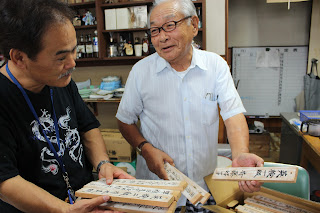"'Nakoso' means 'Do not come here.' Up until 150 years ago, Japanese people were not allowed to leave their own districts. Think about the freedom today, how different things are now that we can travel globally with no difficulties!"
Midori and I were walking in the village one evening when she pointed to the road sign and almost shouted with excitement. In those 150 years, many things changed indeed. Midori is here from a faraway city called Yokohama with no restriction on travel, and I am here from 'the land of enemy' 67 years after the end of WW II. We were walking together in this tsunami-hit town in Japan that has an elderly, rapidly diminishing population (as many families with young children have left Fukushima due to the fear of radiation).
Midori and I just spent a week to write, hang out and get to know this quiet town more closely here with no organizational agenda to visit or interview anyone. I simply wanted to experience the rhythm of life in a small town of Fukushima as people continue to strive for recovery and to move forward. After finishing the week long retreat, as we were leaving Nakoso to come back to Iwaki city I looked at the train station sign, 'Nakoso,' and I prayed to God, 'I don't know when you will bring me here to Nakoso town again, maybe in one year, or maybe in 10 years? Or I may never come back, true to the name, Nakoso. I leave this place and the people of this land to you.'
 |
| Nakoso Station |
This morning we joined the worship at Nakoso Christ Church in Iwaki where Rev. Sumiyoshi works. I wrote the stories of this church a few times, especially following Rev. Sumiyoshi's powerful encounter with Jesus in his dream after the disaster last year (click here) and his vision to follow a Korean Christian martyr who was killed in the prison during the Japanese occupation in Korea (click here). After the service we were invited for lunch with the Sumiyoshi's, and we talked about agriculture and land issues in Fukushima.
Today for the first time, Rev. Sumiyoshi shared his vision of restoring an agricultural village in Fukushima and showed us the land he's been thinking of. For the past few years he has been building a relationship with the owner of this land. Then the disaster happened last year so everything stopped. We drove for about 15 minutes and arrived at the Nakoso station again to park his car! (I couldn't believe my eyes first that God had brought me back here just 26 hours after I had prayed!)
We started walking along narrow paths past some houses and ended up in the field where I'd taken pictures while I went for walks a few times last week!
 |
| Rev. Sumiyoshi in his big smile after hearing my story of walking around this field last week |
"There's a place we should go." We got in the car and he drove us without saying where we were going. We stopped the car in front of a house and an old man came and Rev. Sumiyoshi introduced me to him, as the owner of the land, Mr. Ajima.
 |
| Mr. Ajima showing Rev. Sumiyoshi plaques of his former students |
A retired English teacher who had taught for 50 years in Nakoso, Mr. Ajima received us gladly and was happy for a chance to brush up his English with a stranger (this is a rather unusual happening because Japanese do not normally visit people's homes without prior appointments).
"You have a beautiful piece of land!"
I told him that I was praying for him last week when I was walking through his field. He was very happy to hear that and told us about the history of his land. I also told him that I'd continue to pray for him and his land, and wished God's blessing for him before we left. I gave thanks to God for Mr. Ajima and for his land and for Rev. Sumiyoshi's vision to work with such a holistic vision in his community.
No comments:
Post a Comment